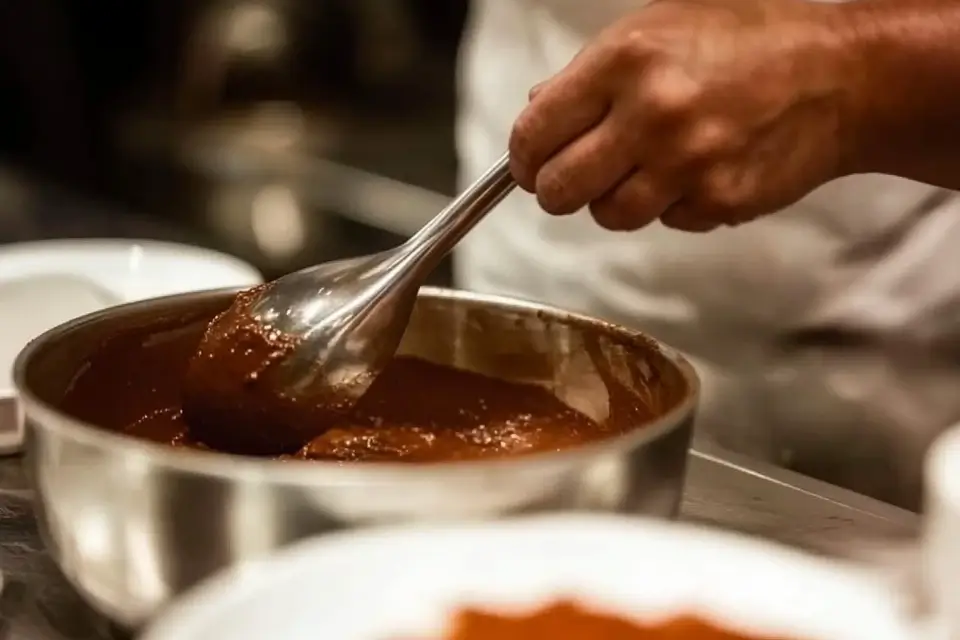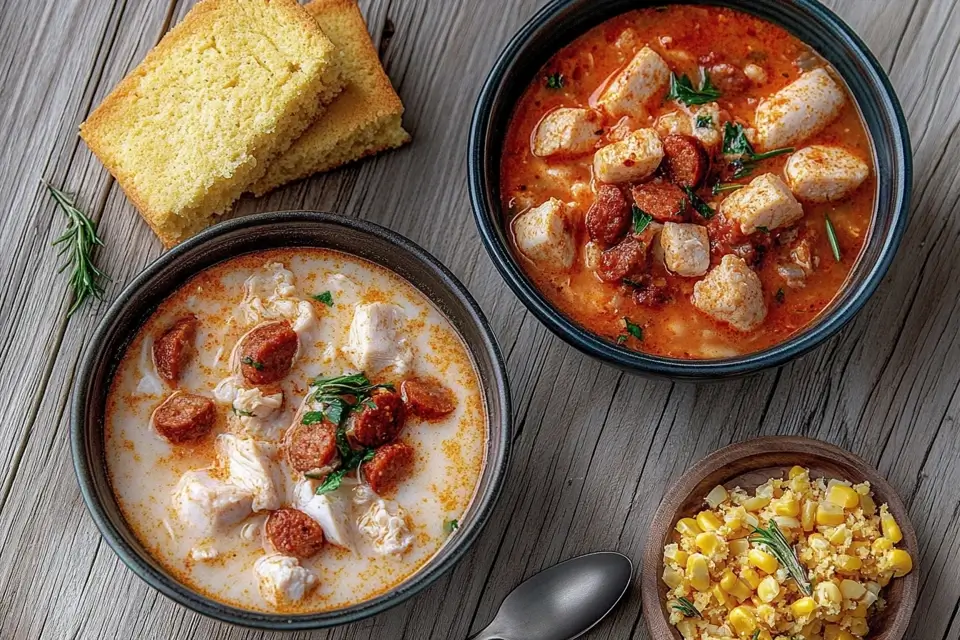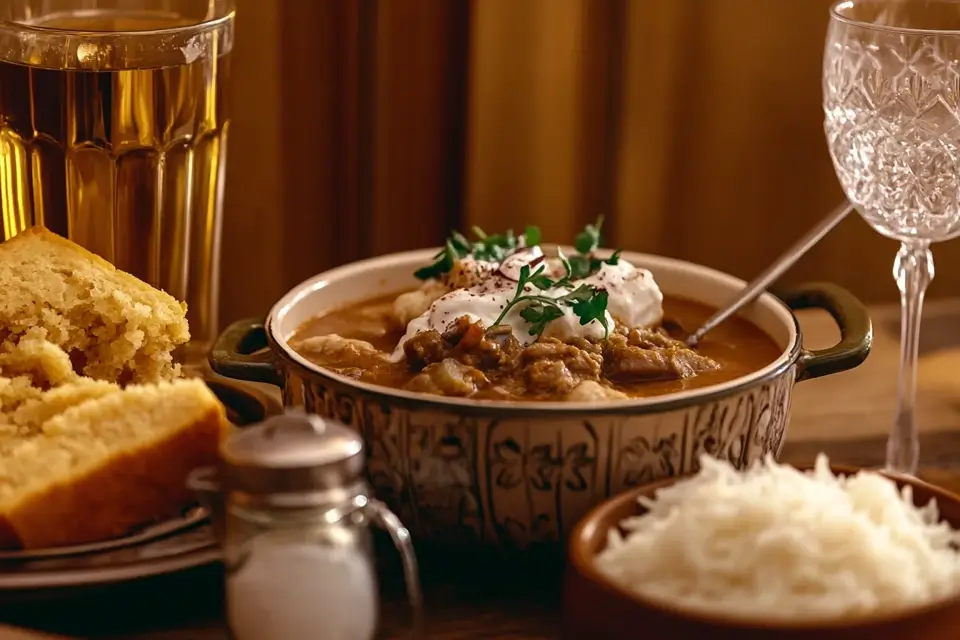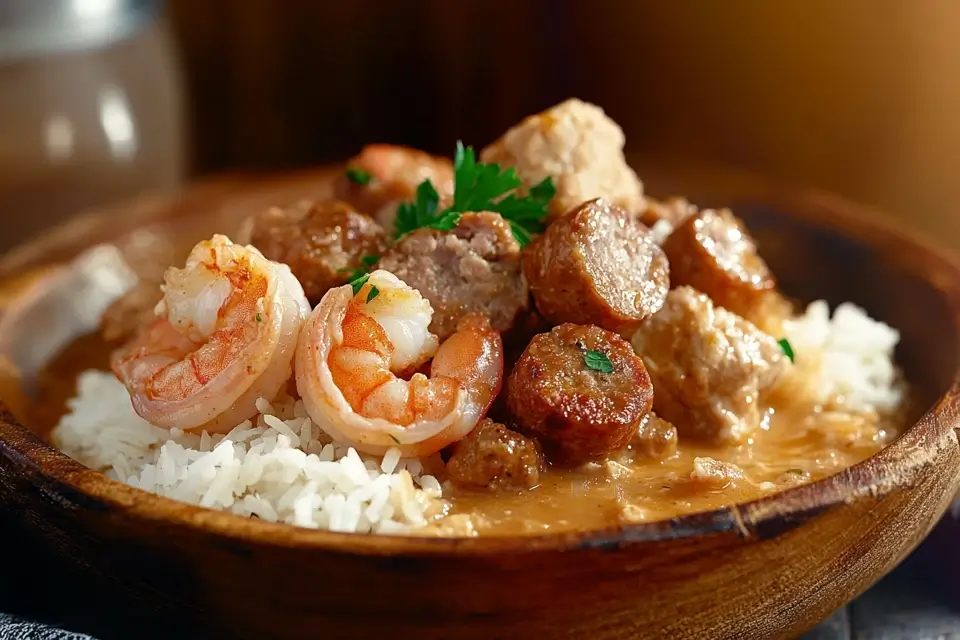Gumbo is more than just a dish; it’s a symbol of Louisiana’s rich culture and history. This savory, flavor-packed stew is a fusion of Cajun and Creole influences, featuring a deep, smoky roux, the Holy Trinity of vegetables, and a combination of meats or seafood. Whether you’re making chicken and sausage gumbo or a seafood gumbo, mastering this dish requires understanding its ingredients, techniques, and history.
In this guide, we’ll break down everything you need to know about making the best gumbo recipe, from its origins to step-by-step cooking instructions. We’ll also cover common mistakes to avoid, variations to try, and serving tips. Ready to dive in? Let’s start with the history behind this beloved dish.
Understanding Gumbo and Its Origins
What Is Gumbo? A Classic Louisiana Dish
Gumbo is a thick, hearty stew traditionally made with a dark roux, a blend of vegetables, and various proteins like chicken, sausage, or seafood. The dish is typically served over rice and flavored with spices and herbs that give it a deep, smoky richness.

“A deep, rich roux being stirred to perfection – the key ingredient for an authentic gumbo recipe.”
“Gumbo is like a melting pot of cultures African, French, Spanish, and Native American influences all in one dish.”
One of the defining characteristics of gumbo is its thickening agent. Depending on the type of gumbo, it can be thickened with:
- Roux – A slow-cooked mixture of flour and fat (usually oil or butter)
- Okra – A green vegetable that naturally thickens the stew
- Filé Powder – A seasoning made from ground sassafras leaves, added at the end of cooking
The History of Gumbo: A Blend of Cultures
The word gumbo is believed to have West African origins, deriving from the word ki ngombo, which means okra. Over time, the dish evolved through a blend of cultural influences, each contributing key ingredients and techniques:
- West African Influence: Okra, brought by enslaved Africans, was used as a natural thickener in early versions of gumbo.
- French Influence: The French introduced roux, a slow-cooked mixture of flour and fat that adds richness and depth.
- Spanish Influence: Spanish settlers incorporated peppers and tomatoes, which are commonly found in Creole-style gumbo.
- Indigenous Influence: Native groups in the region introduced sassafras leaves, which were later ground into filé powder, another traditional thickener.
This fusion of cultures gave birth to the gumbo recipe we know and love today a true representation of Louisiana’s diverse culinary heritage.
By the 18th century, gumbo had become a staple in Louisiana households, adapting to different ingredients based on availability and cultural influences. Today, there are countless variations, each telling its own unique story.
Cajun vs. Creole Gumbo: What’s the Difference?
Many people assume that Cajun and Creole gumbo are the same, but they have key differences:
| Feature | Cajun Gumbo | Creole Gumbo |
|---|---|---|
| Roux | Dark roux made with oil and flour | Lighter roux made with butter and flour |
| Tomatoes | No tomatoes | Often contains tomatoes |
| Meats | Chicken, andouille sausage | Seafood like shrimp, crab, and oysters |
| Thickener | Roux and sometimes filé powder | Often thickened with okra |
“If you see tomatoes in gumbo, you’re likely eating Creole gumbo, not Cajun!”
Both types of gumbo share the same core principles a slow-cooked stew packed with bold flavors, but the choice of ingredients can drastically change the final taste.
Essential Ingredients for Authentic Gumbo
The secret to an amazing gumbo recipe lies in its carefully selected ingredients. Each component plays a crucial role in creating the dish’s rich, deep flavor. Whether you’re making a Cajun-style gumbo with chicken and sausage or a Creole-style seafood gumbo, certain ingredients remain essential.
The Holy Trinity: Onion, Celery, and Bell Pepper
If you’ve ever cooked Cajun or Creole food, you’ve likely heard of the Holy Trinity a blend of onion, celery, and bell pepper. This mixture forms the flavor base of gumbo and many other Louisiana dishes.
“Think of the Holy Trinity as the backbone of your gumbo. Without it, you lose the heart of Louisiana cooking.”
Here’s why each ingredient is important:
- Onions add sweetness and depth.
- Celery provides a subtle earthy crunch.
- Bell peppers bring mild heat and slight bitterness.
For extra flavor, many cooks add garlic, green onions, or poblano peppers to enhance the mix.
The Role of Roux: Dark, Medium, or Light?
Roux is the foundation of any great gumbo. It’s made by slowly cooking flour and fat (oil, butter, or lard) until it reaches a deep, rich color. The darker the roux, the more intense and nutty the flavor.
| Roux Type | Cooking Time | Flavor Profile |
|---|---|---|
| Light Roux | 5-10 minutes | Mild, slightly nutty |
| Medium Roux | 15-20 minutes | Rich, toasty, slightly smoky |
| Dark Roux | 30+ minutes | Deep, bold, intense |
“For a truly authentic gumbo recipe, aim for a dark chocolate-colored roux. But be careful one second too long, and it can burn!”
A properly cooked roux gives gumbo its signature thickness and complexity. Stir constantly to prevent burning!
Choosing the Best Proteins: Chicken, Sausage, and Seafood
Your choice of protein affects the final taste and texture of your gumbo. The most common options include:
- Chicken and Sausage Gumbo (Cajun-style)
- Uses bone-in chicken thighs for more flavor
- Andouille sausage adds a smoky, spicy kick
- Seafood Gumbo (Creole-style)
- Includes shrimp, crab, or oysters
- Often features tomatoes and a lighter roux
Some cooks like to mix both meat and seafood for a surf-and-turf experience!
Okra and Filé Powder: Thickening Agents Explained
Gumbo needs a thick, hearty texture, and two traditional ingredients help achieve that:
- Okra – A green vegetable that naturally thickens the broth. It’s slightly slimy when cooked, but that’s what makes gumbo so rich!
- Filé Powder – Made from ground sassafras leaves, this seasoning thickens gumbo when sprinkled in at the end.
“If you’re using filé powder, never add it while the gumbo is still boiling it’ll turn stringy!”
Now that we’ve covered the ingredients, let’s move on to actually cooking the gumbo!
If you love exploring Southern flavors, you might also enjoy this delicious Southern-inspired dish.
Step-by-Step Guide to Making Gumbo
Making gumbo from scratch requires patience, but the final dish is worth every minute. Follow this step-by-step guide for a perfect, flavor-packed stew.
Preparing the Ingredients: A Gumbo Mis En Place
Before you start cooking, have everything chopped and ready. This includes:
The Holy Trinity (onions, celery, bell peppers)
Garlic (minced)
Chicken, sausage, or seafood
Stock or broth (homemade is best!)
Seasonings (paprika, thyme, cayenne, bay leaves)
Okra or filé powder
Cooking the Roux: Tips for Perfect Color and Flavor
- Heat oil in a large pot over medium heat.
- Slowly whisk in flour, stirring constantly.
- Cook until the roux turns a deep chocolate brown (this takes about 30 minutes).
“If your roux smells burnt, toss it out and start over there’s no saving burnt roux!”
Once your roux is ready, quickly add the Holy Trinity and cook until soft.
Building the Flavor: Adding Vegetables, Meat, and Spices
- Add garlic, thyme, and bay leaves, stirring well.
- If making chicken and sausage gumbo, brown the sausage first, then add the chicken.
- If making seafood gumbo, add shrimp or crab toward the end to prevent overcooking.
- Pour in chicken or seafood stock and bring to a gentle simmer.
Simmering and Serving: How Long Should Gumbo Cook?
Gumbo needs time to develop its rich flavors. Let it simmer for at least 1-2 hours, stirring occasionally.
- Chicken and sausage gumbo benefits from longer cooking (around 2 hours).
- Seafood gumbo should be cooked less than an hour to keep the seafood tender.
Finally, serve your gumbo recipe over steamed white rice, topped with fresh green onions and filé powder.
“The best gumbo is always better the next day flavors deepen as it sits!”
Gumbo Recipe Nutrition Facts
| Nutrient | Amount per Serving |
|---|---|
| Calories | ~350-500 kcal |
| Protein | ~25g |
| Carbohydrates | ~30g |
| Fat | ~18g |
| Fiber | ~4g |
Note: Nutritional values vary depending on ingredients and portion sizes.
For more comfort food ideas, check out this hearty Southern recipe.
Popular Variations of Gumbo
Gumbo is not a one-size-fits-all dish it has evolved over time, resulting in unique versions enjoyed across Louisiana and beyond. Whether you prefer chicken and sausage gumbo, seafood gumbo, or even a plant-based version, there’s a recipe for everyone!

“A delicious spread of two gumbo variations, showcasing the rich diversity of Louisiana-style cooking.”
Chicken and Sausage Gumbo: A Hearty Classic
One of the most popular versions of gumbo is chicken and sausage gumbo, which has deep Cajun roots. The smoky andouille sausage gives it a bold flavor, while tender chicken makes it rich and satisfying.
How to Make It:
Use bone-in chicken thighs for more flavor.
Brown the sausage first to release its smoky juices.
Let the gumbo simmer for at least two hours to deepen the taste.
“A good chicken and sausage gumbo always starts with a dark roux and plenty of seasoning!”
Seafood Gumbo: A Taste of the Gulf
If you love fresh seafood, then you’ll enjoy Creole-style seafood gumbo. This version typically includes shrimp, crab, and sometimes oysters or crawfish.
Tips for the Best Seafood Gumbo:
- Use homemade seafood stock for a more authentic flavor.
- Add shrimp and crab at the end so they don’t overcook.
- Many seafood gumbos include tomatoes, which is common in Creole-style recipes.
“The key to a perfect seafood gumbo is fresh ingredients never overcook your seafood!”
Vegetarian and Vegan Gumbo: Flavor Without Meat
Believe it or not, you can make a delicious gumbo recipe without meat or seafood! This vegan-friendly version still has that rich, smoky taste thanks to the Holy Trinity, okra, and spices.
How to Make Vegan Gumbo:
Use mushrooms, jackfruit, or chickpeas as a meat substitute.
Cook a dark roux with oil instead of butter.
Add smoked paprika and liquid smoke for that deep, umami flavor.
“Vegan gumbo may not have meat, but it still packs a punch with bold flavors and spices!”
Other Unique Gumbo Styles
Gumbo varies from household to household, and some lesser-known versions include:
- Duck and Andouille Gumbo – A gamey, rich dish perfect for fall and winter.
- Turkey Gumbo – A great way to use up leftover Thanksgiving turkey!
- Gumbo Z’Herbes – A meat-free gumbo traditionally made during Lent with leafy greens.
No matter which version you choose, gumbo is all about tradition, family, and flavor.
looking for more traditional Southern recipes, take a look at this collection of must-try dishes.
Tips and Tricks for the Best Gumbo Recipe
Even though gumbo is not difficult to make, small mistakes can affect its flavor. Here are pro tips to ensure your gumbo turns out perfect every time.
How to Make Gumbo More Flavorful
Gumbo should be bold, smoky, and packed with depth. To achieve the best taste, follow these simple tips:
Use homemade stock – Whether it’s chicken, seafood, or vegetable stock, fresh broth enhances the richness of gumbo.
Let the roux cook slowly – A dark roux adds a nutty, toasted taste.
Simmer for at least an hour – The longer it cooks, the better the flavors develop.
Season in layers – Don’t just dump spices in at the end season throughout the cooking process!
Finish with filé powder – This adds a distinct earthy flavor and thickens the gumbo.
“Gumbo isn’t just about ingredients, it’s about technique and patience!”
Common Mistakes to Avoid When Cooking Gumbo
Even experienced cooks sometimes make mistakes when preparing gumbo. Here are the most common pitfalls to watch out for:
Burning the roux – Once burnt, there’s no fixing it. If you see black specks, start over.
Adding filé powder too early – Always add it after cooking, or it will turn gummy.
Overcooking seafood – Shrimp and crab should be added only in the last few minutes.
Not using enough seasoning – Gumbo needs bold spices like cayenne, paprika, and thyme.
Skipping the Holy Trinity – Without onion, celery, and bell pepper, it won’t have that classic Louisiana taste.
Storing and Reheating: Does Gumbo Taste Better the Next Day?
Yes! In fact, gumbo tastes even better the next day because the flavors have more time to blend.
Storage Tips:
- Refrigerate gumbo in an airtight container for up to 4 days.
- Freeze it for up to 3 months, just leave out the rice before freezing.
- Reheat on low heat to maintain its texture and taste.
Serving and Pairing Suggestions
The Best Rice for Gumbo: Long-Grain vs. Jasmine
Gumbo is traditionally served over a bed of rice, but not all rice varieties work the same. The best types of rice for gumbo include:
- Long-Grain White Rice – The most traditional choice, as it stays fluffy and absorbs the gumbo’s rich broth.
- Jasmine Rice – Has a slightly floral aroma that pairs beautifully with Creole-style seafood gumbo.
- Brown Rice – A healthier option with a nutty taste, though it takes longer to cook.
“If you want a true Louisiana-style experience, always serve gumbo over white long-grain rice!”
To serve, ladle your gumbo over a scoop of rice in a deep bowl. Some people like to stir it all together, while others prefer to keep the rice separate until each bite.

“A beautifully set dinner table with gumbo and its best side dishes ready for a comforting, flavorful meal.”
What to Serve with Gumbo: Bread, Cornbread, or Crackers?
A bowl of hot, flavorful gumbo is delicious on its own, but the right side dish can make it even better.
Here are some popular sides to serve with gumbo:
French Bread – The crusty texture is perfect for scooping up every last drop of the rich broth.
Cornbread – A slightly sweet, crumbly bread that contrasts well with spicy gumbo.
Saltine Crackers – A simple, crunchy addition for those who prefer a lighter side.
Potato Salad – Surprisingly, some Louisiana locals eat gumbo with a scoop of potato salad on top!
“No matter what you choose, a good gumbo meal is all about comfort and heartiness.”
Pairing Drinks with Gumbo: From Beer to Sweet Tea
The best drink pairings for gumbo depend on whether it’s Cajun-style (smoky and meaty) or Creole-style (seafood and tomato-based). Choosing the right beverage can enhance the dish’s bold, comforting flavors.
- For Cajun Chicken & Sausage Gumbo: A cold lager or amber ale complements the smoky sausage and spices. If you prefer something non-alcoholic, sweet tea provides a refreshing contrast to the dish’s bold taste.
- For Creole Seafood Gumbo: A crisp white wine like Sauvignon Blanc enhances the freshness of shrimp and crab. On the other hand, a light citrus cocktail pairs beautifully with the tomato-based broth.
- For Non-Alcoholic Options: Classic lemonade or sweet tea helps cool down the heat from Cajun spices. If you prefer something fizzy, sparkling water with a splash of lemon keeps things simple yet refreshing.
“No matter which gumbo you choose, the right drink can elevate the experience!”
FAQs About Gumbo
Gumbo is a dish full of history and tradition, and many people have questions about how to make it right. Below, we answer some of the most common gumbo-related questions!
What are the ingredients in a gumbo?
A classic gumbo recipe includes:
A dark roux (flour + oil or butter)
The Holy Trinity (onions, celery, bell pepper)
Chicken, sausage, shrimp, or crab
Stock or broth
Seasonings (paprika, thyme, cayenne, bay leaves)
A thickener (okra or filé powder)
“The secret to a good gumbo isn’t just the ingredients, it’s how you layer the flavors while cooking!”
What are the two rules of gumbo?
Two golden rules apply to making authentic gumbo:
Don’t burn the roux! A burnt roux ruins the entire dish, so stir constantly and cook it low and slow.
Don’t rush the cooking process. Gumbo needs time to simmer and develop its rich, deep flavor.
“Great gumbo takes patience, but the result is always worth it!”
How to make gumbo more flavorful?
If your gumbo lacks flavor, here are some ways to boost the taste:
Use homemade stock – Store-bought broth works, but homemade chicken or seafood stock makes a big difference.
Cook a dark roux – The darker the roux, the deeper the flavor.
Season in layers – Add spices early and adjust the seasoning throughout the cooking process.
Simmer longer – Let the gumbo cook for at least 1-2 hours to build a richer taste.
Use smoked meats – Andouille sausage or smoked chicken adds an extra layer of boldness.
“A bland gumbo is a crime in Louisiana don’t be afraid to season it well!”
What are the three types of gumbo?
There are many variations, but the three main types of gumbo are:
Chicken and Sausage Gumbo – A hearty, smoky dish with a deep roux and Cajun flavors.
Seafood Gumbo – A Creole-style gumbo with shrimp, crab, and sometimes oysters.
Gumbo Z’Herbes – A meatless gumbo made with leafy greens, often eaten during Lent.
Each type has its own distinctive taste and texture, but they all share the same rich, comforting essence.
“No matter which gumbo you make, the key is cooking it with love and tradition!”
If you’re curious about other classic Louisiana meals, visit this page for more Southern recipes.
Common Gumbo Troubleshooting and Fixes
Even the best cooks sometimes run into problems when making gumbo. If your gumbo doesn’t turn out exactly how you expected, don’t worry these easy fixes will help!
Why is my gumbo too thin?
A good gumbo recipe should have a thick, rich consistency. If your gumbo is too watery, try these solutions:
Simmer it longer – The more time it cooks, the thicker it becomes.
Make a quick roux – In a separate pan, cook equal parts flour and butter until golden brown, then stir it into the gumbo.
Add more okra or filé powder – These natural thickeners can save a runny gumbo.
“A great gumbo should coat the back of a spoon, it shouldn’t be thin like soup!”
Why is my gumbo too thick?
Sometimes, gumbo can turn out too thick and heavy. If that happens, try these fixes:
Add more broth or stock – Slowly stir in warm liquid to reach the right consistency.
Go easy on the filé powder – Adding too much can make gumbo too thick and sticky.
Check your roux – A very thick roux can make gumbo overly dense.
“The best gumbo has a balance between thick and soupy find your perfect texture!”
How do I fix burnt roux?
If your roux burns, there’s no saving it. Unfortunately, the burnt taste will ruin the entire dish. The only solution is to start over.
To prevent burning:
Cook on low heat and stir constantly.
Use a heavy-bottomed pot to avoid hot spots.
Have patience a dark roux takes time but is worth it!
“If you see black specks in your roux, it’s time to toss it out and try again!”
Why does my gumbo taste bland?
If your gumbo lacks flavor, it might need:
More seasoning – Don’t be afraid to add Cajun spices, salt, or hot sauce.
A longer cooking time – Simmering gumbo allows flavors to develop deeply.
Better ingredients – Use homemade stock, fresh vegetables, and high-quality meats for the best taste.
“A bland gumbo is a sad gumbo taste and adjust as you go!”
Customizing Gumbo for Different Diets
One of the best things about gumbo is that you can customize it to fit different dietary needs. Whether you want a healthier version, a spicier kick, or a gluten-free option, there’s a way to make gumbo work for everyone.
Making a Healthier Gumbo
A traditional gumbo recipe can be rich and calorie-dense, but you can make a lighter version without losing flavor.
Use a lighter roux – Instead of a dark, oil-based roux, try using a medium roux with olive oil.
Go lean with protein – Use skinless chicken, turkey sausage, or shrimp.
Reduce salt – Use low-sodium stock and rely on herbs and spices for flavor.
Load up on veggies – Add extra bell peppers, okra, tomatoes, and leafy greens for more nutrition.
“Healthy gumbo is just as delicious it’s all about smart ingredient swaps!”
Spicy vs. Mild Gumbo: Adjusting the Heat
Gumbo can be mild or fiery hot, depending on your preference.
For a spicier gumbo:
- Add Cajun seasoning, cayenne pepper, and diced jalapeños.
- Use extra-spicy andouille sausage.
- Stir in a few dashes of hot sauce before serving.
For a mild gumbo:
- Reduce cayenne and black pepper.
- Use a mild sausage like kielbasa instead of spicy andouille.
- Skip the hot sauce and add more herbs instead.
“The beauty of gumbo is that you control the heat make it as spicy or as mild as you like!”
Gluten-Free Gumbo
If you need a gluten-free gumbo recipe, you’ll need to adjust the roux and thickening agents.
Use gluten-free flour – Almond flour or rice flour works well for roux.
Skip the roux altogether – Rely on okra and filé powder for thickening instead.
Double-check sausage labels – Some brands contain fillers that include gluten.
“You don’t need flour to make an amazing gumbo there are plenty of other ways to get that thick, rich texture!”
Conclusion
Gumbo is more than just a dish, it’s a taste of Louisiana’s history, culture, and tradition. Whether you prefer chicken and sausage gumbo, seafood gumbo, or a vegetarian version, there’s a gumbo recipe for everyone.
By now, you’ve learned:
How to make a perfect roux without burning it.
The best ingredients to create an authentic gumbo.
How to fix common mistakes and customize gumbo for different diets.
Serving tips to make your meal even better.
“The secret to a great gumbo is patience, love, and bold flavors so take your time and enjoy the process!”
Now, it’s time to grab your pot, gather your ingredients, and start cooking! What’s your favorite gumbo variation? Let us know in the comments!
For more Cajun and Creole-inspired dishes, don’t forget to explore these flavorful recipes!

